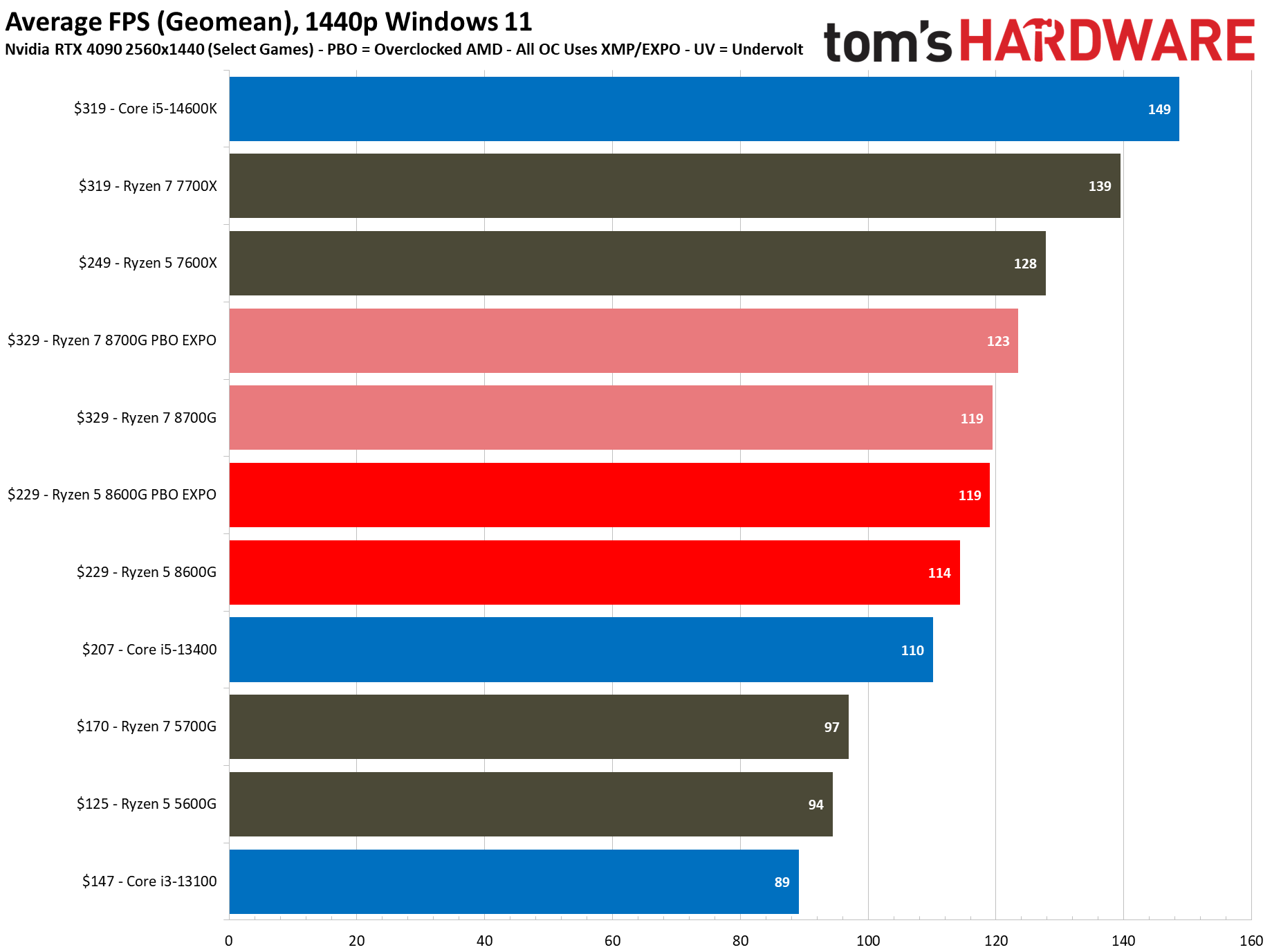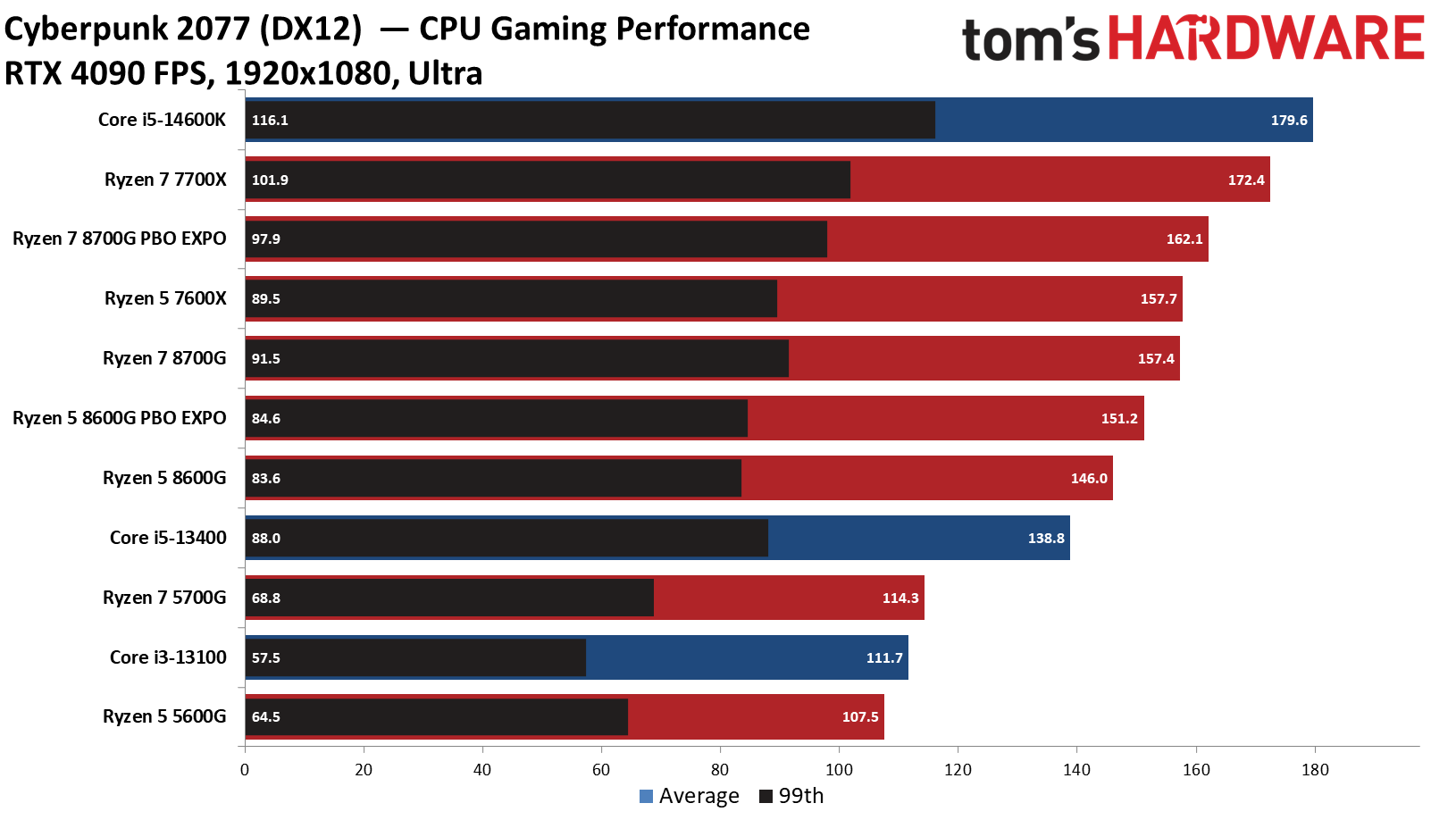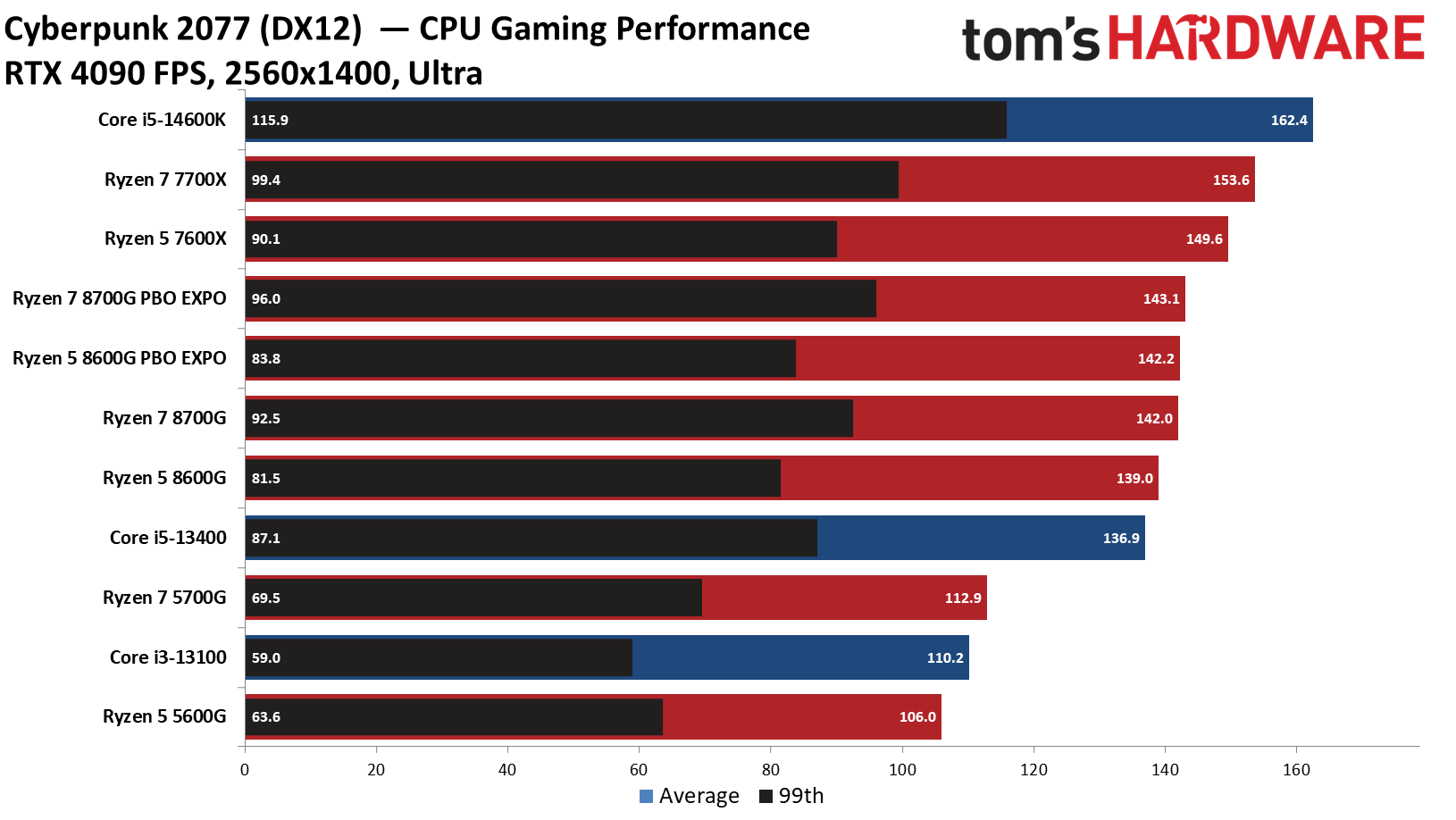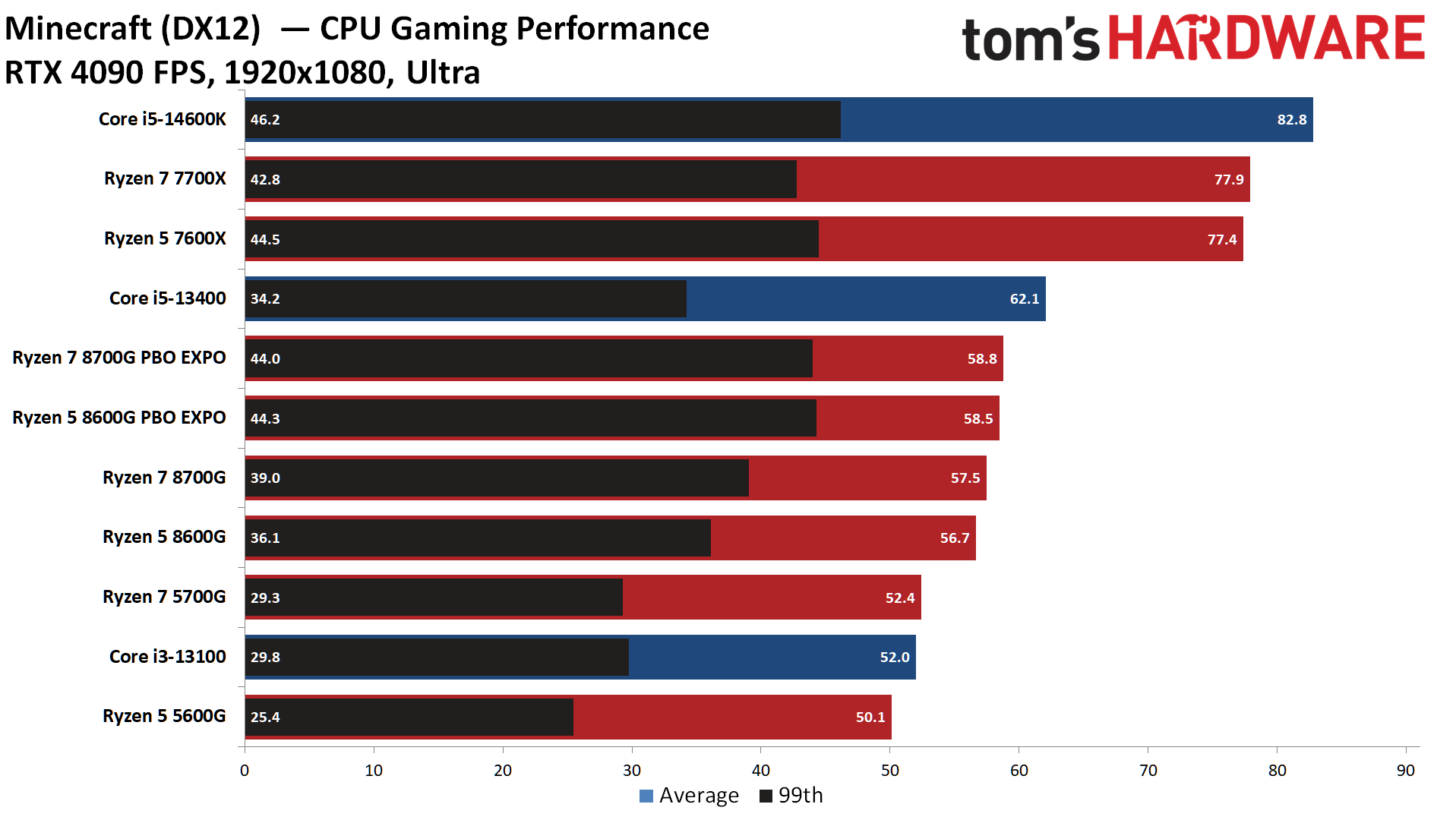Why you can trust Tom's Hardware
AMD Ryzen 5 8600G Discrete GPU Gaming Performance — The TLDR
This class of chip isn't meant to be paired with a discrete GPU, but these benchmarks are useful info if you plan to upgrade to a more powerful GPU in the future. We include these results for the sake of being complete, but the iGPU benchmarks on the preceding page are far more relevant for the Ryzen 8000G APUs.
Below, you can see the geometric mean of our gaming tests at 1080p and 1440p, with each resolution split into its own separate chart. Per our standard policy, we tested with an Nvidia GeForce RTX 4090 to reduce GPU-imposed bottlenecks as much as possible. Still, differences between test subjects will shrink with less powerful cards or higher resolutions.
These are cumulative metrics of our dGPU test suite, so individual wins vary on a per-title basis, which you can see further below. Some of these same benchmarks appeared in our integrated GPU testing on the prior page, but we used much higher quality settings for the tests below.




We have a somewhat different test grouping for this series of benchmarks. We added a few AMD Ryzen 7000 models to the mix, and they clearly have much higher overall performance with a discrete GPU than the Ryzen 8000G models.
For instance, the price-comparable six-core $249 Ryzen 5 7600X is 15% faster than the Ryzen 5 8600G. An overclock does help the latter improve its standing, but the 7600X is also overclockable, which would provide it a further lead. Notably, the 7600X also comes as a 'non-X' model, the Ryzen 5 7600, which is ~$30 less than the X-equipped counterpart yet provides nearly the same performance. The performance is so close that we use the 'X' models as proxies, but you can find an even better deal and similar performance from the Zen 4 camp for less than shown here.
The 8600G is 22% faster than the Core i3-13100 but also carries a premium. The Intel Core i5-13400 lands between the Ryzen 5 8600G and the Ryzen 7 8700G, with slim margins separating the chips on either side. In contrast, the Core i5-14600K is on another level, delivering 30% more performance than the Ryzen 5 8600G.
The Ryzen 5 8600G is 20% faster than the previous-gen Ryzen 5 5600G. Overclocking can also squeeze out an extra 8% performance, but you'll have to balance that with the cost it will add to your build.
The Ryzen 5 8600G isn't the best option if you use a discrete graphics card. Both AMD and Intel have much better chips for systems focused on discrete GPUs.
We've included the full gaming benchmarks below, but given that this isn't the targeted use case for this chip, we'll skip the commentary.
Borderlands 3 on AMD Ryzen 5 8600G


Cyberpunk 2077 on AMD Ryzen 5 8600G


F1 2023 on AMD Ryzen 5 8600G

Far Cry 6 on AMD Ryzen 5 8600G


Hitman 3 on AMD Ryzen 5 8600G


Minecraft on AMD Ryzen 5 8600G

Microsoft Flight Simulator 2021 on AMD Ryzen 5 8600G


Watch Dogs Legion on AMD Ryzen 5 8600G


Factorio on AMD Ryzen 5 8600G


Get Tom's Hardware's best news and in-depth reviews, straight to your inbox.
Current page: AMD Ryzen 5 8600G Discrete GPU Gaming Performance
Prev Page AMD Ryzen 5 8600G iGPU Gaming Benchmarks Next Page AMD Ryzen 5 8600G Application Benchmarks
Paul Alcorn is the Editor-in-Chief for Tom's Hardware US. He also writes news and reviews on CPUs, storage, and enterprise hardware.
-
Notton Considering how the Core 5 135H is looking, I really wish AMD enabled the full 12CU from this chip.Reply -
usertests APUs are screaming for more memory bandwidth, and the 8600G will look great if it hits the low prices seen for the 5600G along with other platform costs getting cheaper.Reply -
baboma >The current-gen flagship APU, the Ryzen 7 8700G, is 10% faster than the 8600G, but it costs $100 (44%) more, making the 8600G the clear value winner for this generation of APUs.Reply
This is incorrect, because you do not use the APU by itself, but as a part of a system. The correct value calculation is to take the price delta of the entire system but with different APUs.
Assuming a $1K SFF build, the $100 APU price diff would come out to ~10%, which is the same perf diff between 8700G and 8600G. AMD did its pricing homework. The value proposition is the same for both APUs.
I agree both are niche, as their main appeal would be for small SFF (eg NUC), and in that space, mobile parts, eg MTL & AMD 780M parts, may have more functionality and be better value.
>...the 8600G will look great if it hits the low prices seen for the 5600G along with other platform costs getting cheaper.
That'll happen if you're willing to wait ~2 years until the 9600G's release.
5600G pricing was very stable, staying close to its $259 launch price, and only gradually dropping after the 7000 series release on Sep'22.
https://camelcamelcamel.com/product/B092L9GF5N -
jeremyj_83 "Higher DDR5 pricing, no 8GB options"Reply
I am so tired of hearing about DDR5 pricing being a con. While it is more expensive, you won't have a choice for a new CPU in the Zen 5 or 15th Gen anyways. Not to mention due to the added bandwidth the 8600G averages 72% more iGPU performance at 1080p vs the 5600G. If you are looking at doing only iGPU gaming that added cost is minimal compared to extra performance. The lack of an 8GB option is also not a con. Gaming on 8GB is with a dGPU isn't good, unless it is old games. Doing it on an iGPU can kill your performance completely. -
SunMaster I think in most cases the APU will be preferable over the CPU with the old graphics card.Reply
If price is your only reason to go for a system like this, and you badly want to game, the APU isn't the best solution. But case/enclosure size, heat and noise will be the primary reason to choose the APU. The fact that you actually can game on it will what makes the sale. -
Reply
A few years ago I played through the entirety of Star Wars Jedi: Fallen Order on a Ryzen 3200G (no dedicated GPU) and with a 4GB x 2 kit of RAM. The Series S also works fine with what is functionally only 8 GB of RAM shared between the CPU and GPU (there's technically +2 GB for a total of 10, but the extra 2 GB is clocked slow and is for the OS). Memory needs tend to be overstated.jeremyj_83 said:The lack of an 8GB option is also not a con. Gaming on 8GB is with a dGPU isn't good, unless it is old games. Doing it on an iGPU can kill your performance completely. -
jeremyj_83 Reply
Have you tried to do basic work on a computer with Win 10, 8GB RAM, and 2GB RAM reserved for the iGPU? It is painfully slow as you are page swapping all the time. Any computer that isn't a Chromebook should come with less than 16GB RAM now.HopefulToad said:Memory needs tend to be overstated. -
kyzarvs Reply
My desktop is a 32GB ram machine. I also have an i7 / 32gb / 2TB nvme gaming laptop.jeremyj_83 said:Have you tried to do basic work on a computer with Win 10, 8GB RAM, and 2GB RAM reserved for the iGPU? It is painfully slow as you are page swapping all the time. Any computer that isn't a Chromebook should come with less than 16GB RAM now.
When I want portability on the road, I have a dell notebook that's education-oriented. 4GB ram, no fans, small CPU. It runs 10/11 perfectly well, starts up quickly and performs my work requirements (Office / Firefox / NextCloud) pretty much as quick as my main machines. -
mitch074 Erm... Error in the article : Zen3 was using 7nm, not 12 - AMD dropped 12nm with Zen 2 and RDNA.Reply
